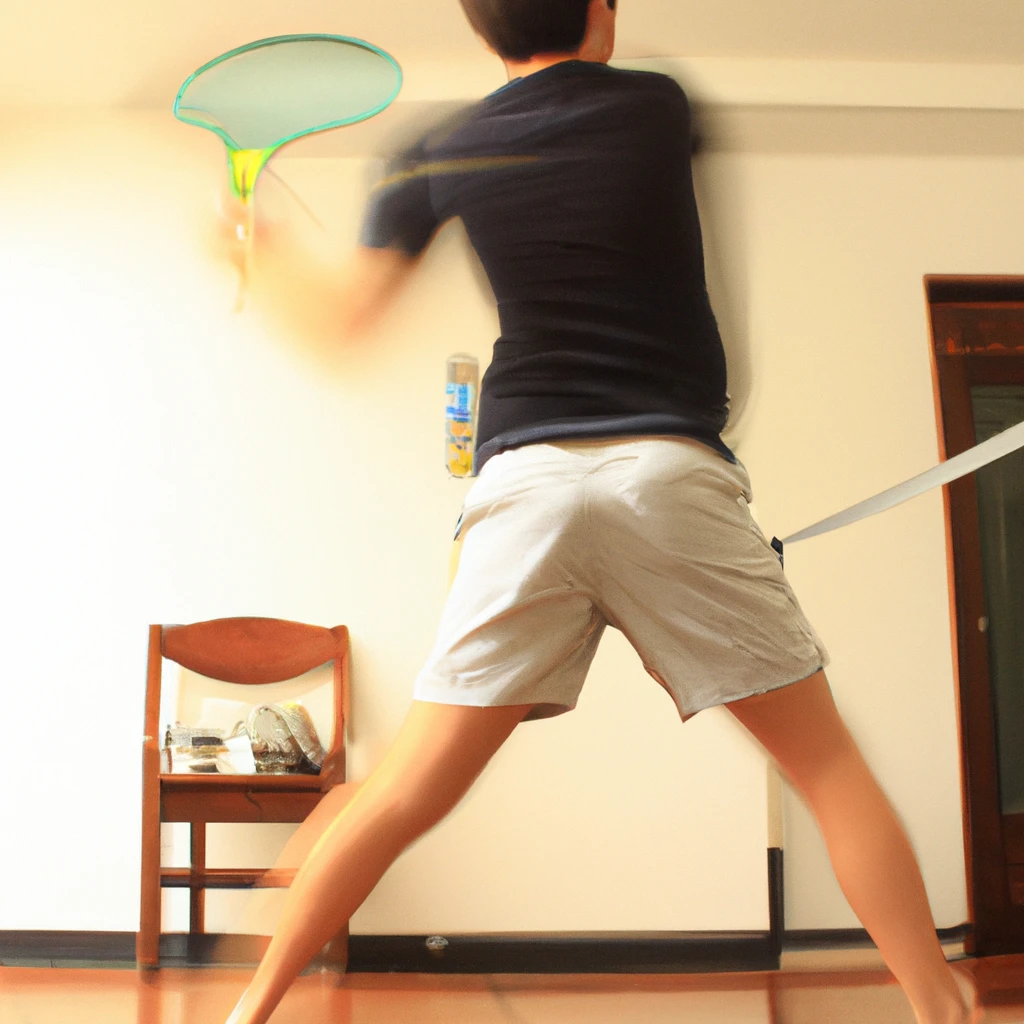Let’s imagine, just for a moment, you’re stepping out on the court at Wimbledon. You can almost hear the crowd, smell the freshly cut grass, feel the weight of the racket in your hands. Tennis isn’t just a game for you. It’s a way of life. But we can’t all have the luxury of a tennis court in our backyard. The reality is that many of us are stuck at home, impatiently waiting for our chance to get back out there and hold our own in a fierce rally. But that doesn’t mean you can’t keep refining your skills, even in the confines of your own home.
This guide will show you how to practice tennis at home with simple exercises and wall drills. It covers everything from elevating your skills, enhancing your footwork, improving your serve, to building stamina. And, while we can’t promise you’ll be the next Serena Williams or Roger Federer, we can guarantee these drills will keep your skills sharp and game ready for your next match.
Mastering the Basics: Tennis Skills to Practice at Home
If you’re determined to take your tennis game higher, the secret lies in strategically adding tennis-specific exercises to your regular fitness training. Exercises that improve spinal mobility and strengthen your core, such as ‘Thread the Needle’ and ‘Book Opening’, are great.
Remember: warming up before a workout is crucial. Increasing your heart rate, adapting blood pressure, and raising body temperature is your goal here. This can be done through biking, jogging, or executing specific tennis moves.
Tennis calls for short, energetic movements – so, include full-body exercises in your routine to make your training even more impactful. You might also want to explore high-octane circuit workouts for that pro-level intensity.
For more guidance, there are numerous workout videos tailored for tennis players. These offer not only demonstrations but also valuable advice from experts. It’s like a personal training session straight from your living room!
Improving your skills isn’t an overnight process – it requires patience and consistency. But with dedication, positivity, and a passion for tennis, you can surely push your game further. So, time to pull out your tennis gear and get started on these exercises.
Enhancing Your Tennis Footwork with Home Drills
In tennis, nimble footwork isn’t just an added advantage; it’s a crucial component of the game. Picture it: You’re on the court, and the ball’s zipping from corner to corner. Without the right footwork, you’ll struggle to keep up. But fear not, friend! You can hone these skills right at the comfort of your home.
Start off with some quick and continuous skipping. This isn’t just for kiddos on the playground, it’s a great way to improve your foot speed and agility! Next, try the ladder drill. If you don’t have an actual agility ladder, no problem! You can use chalk or tape to create one on your floor. Run through it with high knees, in-and-outs, or lateral steps. It’s a fantastic way to work on speed and coordination.
The shuffle drill is another must. Stand straight, begin by quickly shuffling to one side, shuffle back and then shuffle to the other side. It helps mimic the side-to-side movements in tennis. And of course, don’t forget the pivotal toe touches. They might seem simple, but touching each foot briefly in front, to the side, and then behind you can work wonders in enhancing your dexterity and balance!
With consistent practice, you’ll see your in-game footwork improve by leaps and bounds. Remember, it’s not the size of the court that matters, it’s how you move on it!
Improve Your Tennis Serve: Indoor Training Techniques
One of the most effective ways to improve your tennis game, even while at home, is by focusing on your serve technique. Remember, a solid serve can dictate the start and overall course of a game. But how can you work on it without setting foot on a court? Keep reading, I’ve got some remarkable indoor training techniques lined up for you.
Begin by simulating your serve motion without a racket. Focus on your toss, your contact, and your follow through. It’s all about creating that muscle memory in your arm and shoulder. You might feel strange swinging at an imaginary ball, but this practice can pay off big time once you step back on the court.
How about using a wall? Stand about 10-15 feet away from a wall, as if the wall were the net. Toss the ball and make your serving motion, aiming to hit high on the wall with enough force to bounce back to you. This can give you insight into the strength of your serve and highlight areas where you need to work on your power.
Finally, invest in some reaction balls. These small, oddly-shaped balls bounce in unpredictable directions, requiring quick reflexes to catch. Try throwing a reaction ball against a wall and catching it as it bounces back. This exercise can enhance your coordination, speed and reaction time, all essential elements for a killer tennis serve.
So there you have it! A few simple, yet effective techniques you can practice right in your living room. Remember, consistency is key in tennis. Keep practicing, even on the days when you don’t feel like it. I promise; your serve will thank you.
Building Tennis Stamina: Home Workout Regime
Sure thing, let’s get right to it. Stamina is key in tennis. But how can you work on it while at home, you wonder. Well, it’s not as daunting as it might seem at first. Happily, I’ve got you covered with a simple yet effective home workout routine designed just for tennis players like you.
Before anything else, remember to always start with a proper warm-up. A good dose of jumping jacks and light jogging in place for about five minutes should get your heart rate up and your muscles ready. Then, it’s time to move on to the main event.
Remember, tennis is all about short, explosive movements, so High-Intensity Interval Training (HIIT) workouts are just right to mimic that dynamic. And the plus side? They don’t require any specialized equipment!
Here’s a simple HIIT routine to try: 20 seconds of high knees, followed by 10 seconds of rest. Repeat this eight times. Then do the same with exercises like squats, lunges, and burpees. You can adjust the duration and difficulty of the exercises based on your stamina level. The goal is to keep improving.
Another important aspect of tennis is full-body training; thus, medicine ball exercises like Russian twists and medicine ball slams can help you work on your strength and power.
Lastly, don’t forget the importance of flexibility. So, always wrap up your workout with some stretching exercises. This will aid in recovery and help prevent injuries.
By keeping up with this home workout regime, you’re sure to see improvements on the court once you’re back hitting those powerful backhands and running for every shot. Just remember, consistency is key!
Wall Drills to Perfect Your Forehand and Backhand
Now let’s delve into some powerful exercises you can perform at home to improve your forehand and backhand skills. These wall drills are not just about hitting the ball in repetition but also about proper body mechanics and precision.
Start with your forehand wall volleys. Stand close to the wall and focus on maintaining a consistent rhythm, hitting the ball back to the wall. What you’re aiming for here is not power, but control and accuracy. With every hit, your racket should touch the ball just right, helping you to perfect the art of timing.
Next up, backhand wall volleys. This element of tennis can be trickier. Stand sideways relative to the wall. While maintaining the side-on position, propel the ball towards the wall using your backhand swing. This exercise will help engage the right muscles and improve your backhand accuracy over time.
You can then proceed to practice open stance wall volleys, first for the backhand and then for the forehand. This stance provides a more powerful swing and wider range of motion. It can be key when scrambling to hit wide balls or when generating more power in your shots.
Finally, practice your closed stance wall volleys with your forehand. In this position, your feet should be parallel to the net or wall. It will strengthen the fundamentals of your forehand, encouraging you to utilize your whole body to generate power.
Incorporate these drills into your daily routine, and soon you’ll notice an increase in your forehand and backhand accuracy, power, and control. Remember: Practice makes perfect in tennis, just like in life.
Indoor Drills to Improve Your Net Play
Playing efficiently at the net can truly elevate your tennis game. Let me share with you some effective home drills that can help you improve your net skills without even stepping on a court.
One comprehensive exercise you could try is the Opposite Hand Bounce Downs. What you want to do is to bounce the ball from your racquet to the ground using your non-dominant hand. This unique exercise aids in sharpening your control and command over the ball, fostering smoother transitions when you’re playing at the net.
A similarly effective practice is the Race Track Rolls drill. In this exercise, your goal is to roll the ball on your racquet strings around the outer-frame in a fluid, controlled manner. Just like driving a car on a racetrack, the exercise demands focus and precision. This drill particularly enhances your touch and finesse at the net, making every volley count.
Remember, these exercises may seem simple, but they harness the vital aspects of net play. With regular practice, expect to see substantial improvements in your upfront game.





















